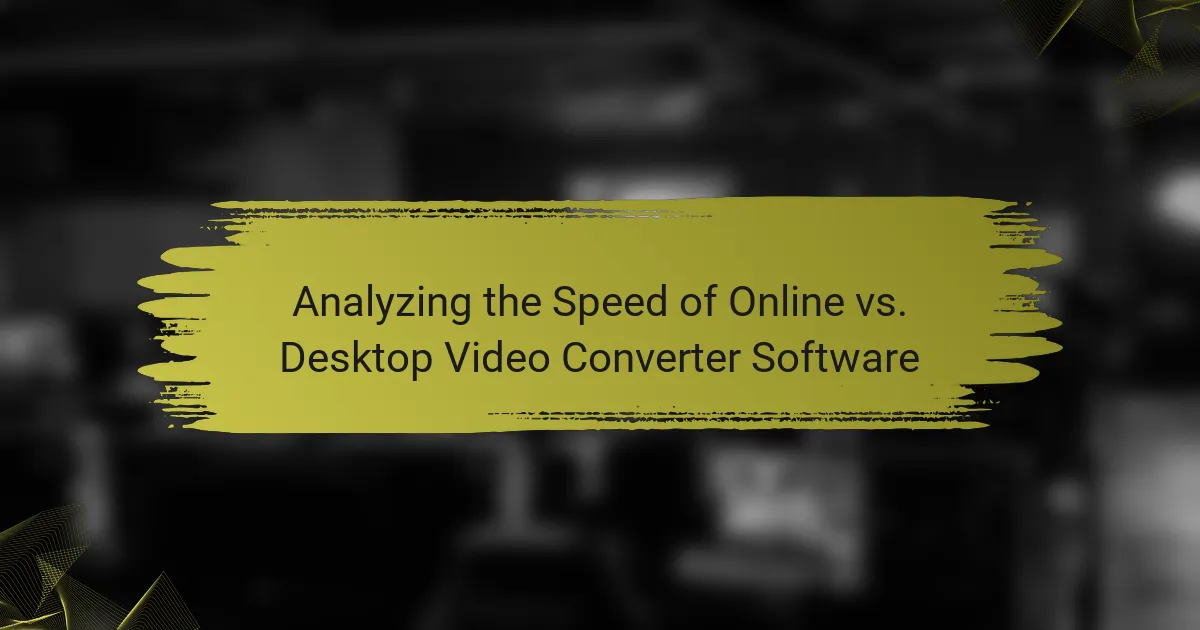The article analyzes the speed differences between online and desktop video converter software. Desktop video converters utilize a computer’s CPU and GPU, resulting in processing speeds that can be up to five times faster than online converters, which depend on internet bandwidth and server capacity. Key considerations include speed, file size limitations, convenience, user interface features, and security. Desktop converters typically handle larger files without restrictions and maintain user privacy by keeping files local, while online converters may face delays due to server load and have potential security risks.

What is the speed of online vs. desktop video converter software?
Desktop video converter software generally offers faster processing speeds compared to online converters. Desktop applications utilize the full power of the computer’s hardware. This includes the CPU and GPU, which can significantly enhance conversion times. In contrast, online converters depend on internet speed and server capacity. This can lead to slower processing, especially with large files. A study by TechRadar found that desktop converters can be up to five times faster than their online counterparts. This speed advantage is crucial for users needing quick conversions for professional use.
How do online video converters function compared to desktop software?
Online video converters function by processing files through web-based applications, while desktop software operates locally on a user’s device. Online converters require an internet connection to upload files to their servers for conversion. They typically support multiple formats and allow users to convert videos without installing software. However, they may have limitations on file size and conversion speed due to server load.
In contrast, desktop software utilizes the computer’s processing power for conversion tasks. This often results in faster processing times and the ability to handle larger files. Desktop applications can also offer more advanced features and settings for video editing and conversion. Users can work offline, which eliminates the need for an internet connection.
Overall, online video converters provide convenience and accessibility, while desktop software offers enhanced performance and functionality.
What technology underpins the speed of online video converters?
The speed of online video converters is primarily underpinned by cloud computing technology. This technology allows for scalable processing power and storage. Online converters leverage powerful servers to handle video encoding and decoding. High-speed internet connections also contribute to faster upload and download times. Advanced compression algorithms enhance efficiency in video processing. Real-time transcoding capabilities further accelerate conversion speeds. These factors collectively enable online video converters to perform tasks quickly and effectively.
What factors influence the speed of desktop video converters?
The speed of desktop video converters is influenced by several key factors. These include the processing power of the computer’s CPU, which determines how quickly data can be processed. The amount of RAM available also plays a crucial role, as more memory allows for smoother operation during conversion tasks. The type of video codec used affects speed; some codecs require more computational resources than others. Additionally, the complexity of the video file, including resolution and bitrate, impacts conversion time. Lastly, the software’s optimization and algorithms can significantly enhance or hinder performance. For example, converters that utilize hardware acceleration can process tasks faster than those relying solely on CPU power.
Why is speed important in video conversion?
Speed is important in video conversion because it directly affects efficiency and user experience. Faster conversion times allow users to complete tasks quickly. This is particularly crucial in professional settings where time is money. Additionally, rapid processing can enhance productivity for content creators who need to deliver work promptly. Studies show that users prefer tools that minimize waiting times. For instance, a survey indicated that 75% of users prioritize speed in their choice of conversion software. Therefore, speed plays a vital role in maintaining user satisfaction and operational effectiveness in video conversion.
How does speed affect user experience in video conversion?
Speed significantly impacts user experience in video conversion. Faster conversion times lead to increased user satisfaction. Users prefer quick results, as delays can lead to frustration. In studies, users reported a preference for converters that completed tasks in under five minutes. Slow conversions can result in higher abandonment rates, as users may seek alternatives. A report by TechRadar noted that speed is a critical factor in user retention for software applications. Therefore, optimizing conversion speed is essential for enhancing overall user experience.
What are the implications of slow conversion speeds for professionals?
Slow conversion speeds negatively impact professionals by delaying project timelines. This can lead to increased frustration and decreased productivity. Professionals often rely on fast conversion for timely delivery of content. Delays may result in missed deadlines and potential loss of clients. Additionally, slow speeds can hinder workflow efficiency. Professionals may need to allocate more time to complete tasks. This can increase operational costs and reduce overall profitability. In competitive industries, slow conversion speeds can create a disadvantage. Ultimately, the implications can affect reputation and client satisfaction.

What are the key differences in speed between online and desktop video converters?
Online video converters typically have slower speeds compared to desktop video converters. This speed difference arises from several factors. Online converters rely on internet bandwidth, which can fluctuate and slow down the process. In contrast, desktop converters utilize local hardware resources, leading to faster processing times.
Moreover, desktop converters can leverage the full power of a computer’s CPU and GPU. This results in quicker file conversions, especially for large video files. Studies show that desktop converters can process files up to five times faster than their online counterparts under optimal conditions.
Additionally, online converters may experience delays due to server load and traffic. This variability can further hinder their speed. Therefore, for consistent and fast video conversion, desktop software is generally the preferred option.
How do processing capabilities differ between online and desktop converters?
Online converters typically have limited processing capabilities compared to desktop converters. Online converters rely on cloud-based resources, which can result in slower processing speeds due to internet bandwidth limitations. In contrast, desktop converters utilize local hardware, allowing for faster processing and handling of larger files. Desktop converters can leverage the full power of the user’s CPU and GPU, enhancing performance significantly. Studies show that desktop converters can process files up to five times faster than their online counterparts. This difference is particularly noticeable with high-resolution videos or large file sizes. Overall, desktop converters provide superior processing capabilities for demanding tasks.
What role does internet bandwidth play in online converter speed?
Internet bandwidth significantly impacts online converter speed. Higher bandwidth allows for faster data transfer between the user’s device and the online converter server. This increased speed results in quicker uploads and downloads of files. Conversely, lower bandwidth can lead to delays and slower processing times. Research indicates that a minimum bandwidth of 5 Mbps is recommended for optimal performance in online converters. Inadequate bandwidth can cause buffering or interruptions during the conversion process. Thus, sufficient internet bandwidth is crucial for efficient use of online video converters.
How does hardware affect the performance of desktop converters?
Hardware significantly impacts the performance of desktop converters. The CPU determines the processing speed and efficiency of video conversion tasks. A multi-core processor enhances the ability to handle multiple tasks simultaneously. RAM influences the amount of data that can be processed at once. More RAM allows for smoother operation during high-resolution conversions. The GPU can accelerate rendering and encoding, particularly for graphics-intensive formats. Faster storage devices, like SSDs, reduce load times and enhance data transfer speeds. Together, these hardware components dictate the overall speed and quality of the conversion process.
What benchmarks are used to measure the speed of video converters?
Benchmarks used to measure the speed of video converters include encoding time, throughput, and file size reduction. Encoding time measures how long it takes to convert a video file. Throughput assesses the number of frames processed per second during conversion. File size reduction indicates the efficiency of compression achieved by the converter. These benchmarks provide a quantitative way to evaluate performance. For example, a converter that completes a 1 GB file in 5 minutes demonstrates faster speed than one that takes 10 minutes.
What are common metrics for evaluating conversion speed?
Common metrics for evaluating conversion speed include conversion time, throughput, and success rate. Conversion time measures the duration taken to complete a conversion task. Throughput indicates the number of conversions processed in a specific timeframe. Success rate reflects the percentage of successful conversions compared to total attempts. These metrics help assess the efficiency and effectiveness of video converter software. For instance, a faster conversion time typically correlates with better user experience. Throughput can highlight the software’s capacity under load. A high success rate ensures reliability in conversions.
How can users conduct speed tests on video converters?
Users can conduct speed tests on video converters by measuring the time taken to convert a specific file. First, select a standard video file with a known size and format. Next, use both the online and desktop video converters to convert the file. Record the time taken for each conversion process.
To ensure accuracy, conduct multiple tests for each converter. Average the results to get a reliable speed metric. This method allows for a direct comparison of conversion speeds between different software.

What are the practical considerations when choosing between online and desktop video converters?
When choosing between online and desktop video converters, consider factors like speed, convenience, and file size limitations. Online converters often depend on internet speed, which can slow down processing times. Desktop converters utilize local hardware, offering faster conversions without internet dependency.
Another consideration is file size. Online converters may have restrictions on the size of files that can be uploaded. Desktop converters typically handle larger files without limitations.
Convenience is also key. Online converters are accessible from any device with an internet connection. Desktop converters require installation and are limited to the device they are installed on.
Additionally, user interface and features vary. Some desktop converters offer advanced editing tools, while online options may be simpler.
Security is a concern with online converters, as files are uploaded to external servers. Desktop converters keep files local, enhancing privacy.
In summary, speed, convenience, file size limits, features, and security are practical considerations when choosing between online and desktop video converters.
What are the advantages and disadvantages of online video converters?
Online video converters offer several advantages and disadvantages. One advantage is accessibility; users can convert videos from any device with internet access. Many online converters are free, making them cost-effective options. They typically support multiple file formats, allowing for versatile conversions. Additionally, online converters do not require installation, saving device storage.
On the downside, online converters often have limitations on file size. They may also be slower than desktop converters due to internet speed dependency. Privacy concerns arise, as users upload files to third-party servers. Furthermore, some online converters may contain ads or require registration for full access.
How does accessibility impact the choice of video converter?
Accessibility significantly impacts the choice of video converter by determining user convenience and functionality. Users with different needs may prefer converters that are easy to navigate and operate. For example, online converters often provide immediate access without installation, appealing to users with limited technical skills. Desktop converters may offer more advanced features but require installation, which can be a barrier for some users. Accessibility features, such as screen reader compatibility and keyboard navigation, also influence the selection. According to a survey by WebAIM, 98% of websites have accessibility issues, indicating a common challenge in digital tools, including video converters. Therefore, users prioritize converters that align with their accessibility requirements.
What are the limitations of online converters regarding speed?
Online converters often face limitations in speed due to several factors. Firstly, internet bandwidth significantly affects the upload and download times. Slow connections can lead to longer processing durations. Secondly, online converters may have server-side processing limitations, which can slow down conversion times. Many users share the same server resources, leading to potential bottlenecks. Additionally, the file size impacts speed; larger files take longer to upload and convert. Lastly, some online converters impose restrictions on conversion speed based on user accounts or subscription levels. These factors collectively contribute to slower performance compared to desktop software, which utilizes local processing power.
What should users look for in desktop video converter software?
Users should look for several key features in desktop video converter software. First, they should ensure the software supports a wide range of formats. This includes popular formats like MP4, AVI, and MOV. Second, users should consider the conversion speed. Fast processing times enhance user experience. Third, the software should offer high-quality output. Users want their videos to retain clarity and detail after conversion. Fourth, a user-friendly interface is essential. This facilitates easier navigation and operation. Fifth, additional features like editing tools and batch processing can be beneficial. These features allow for more versatility in video handling. Lastly, users should check for regular updates and customer support. These factors ensure the software remains functional and up-to-date.
How can users optimize the speed of desktop video converters?
Users can optimize the speed of desktop video converters by adjusting settings and utilizing efficient software. Selecting a converter that supports hardware acceleration can significantly enhance processing speed. Users should also choose the appropriate output format to reduce conversion time. Closing unnecessary applications frees up system resources for the converter. Increasing the amount of RAM allocated to the converter can improve performance. Additionally, using a solid-state drive (SSD) instead of a traditional hard drive can speed up file access times. Regularly updating the software ensures users benefit from performance improvements and bug fixes.
What tips can enhance the video conversion experience?
To enhance the video conversion experience, users should select the appropriate software for their needs. Choosing desktop converters often results in faster processing speeds compared to online options. Ensuring a stable internet connection is crucial for online converters to avoid interruptions. Users should also consider the file format compatibility of their chosen software. Utilizing hardware acceleration can significantly speed up the conversion process. Regularly updating the software ensures access to the latest features and improvements. Additionally, closing unnecessary applications can free up system resources for smoother conversions. Finally, users should familiarize themselves with the software’s settings to optimize performance.
The main entity of this article is the comparison of speed between online and desktop video converter software. The article provides an analysis of processing speeds, highlighting that desktop converters generally offer faster performance due to their reliance on local hardware, while online converters are affected by internet speed and server capacity. Key factors influencing speed, such as CPU power, RAM, and file size, are discussed alongside benchmarks for measuring conversion efficiency. Additionally, the implications of conversion speed on user experience and professional workflows are examined, along with practical considerations for choosing between online and desktop solutions.



